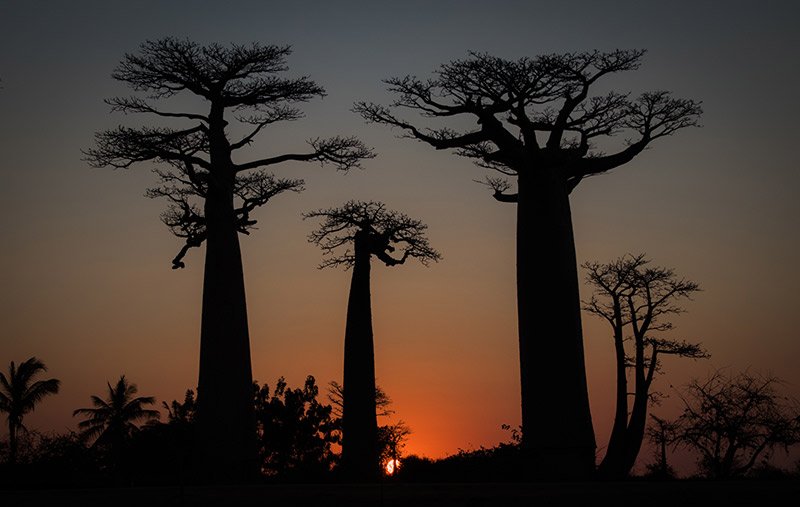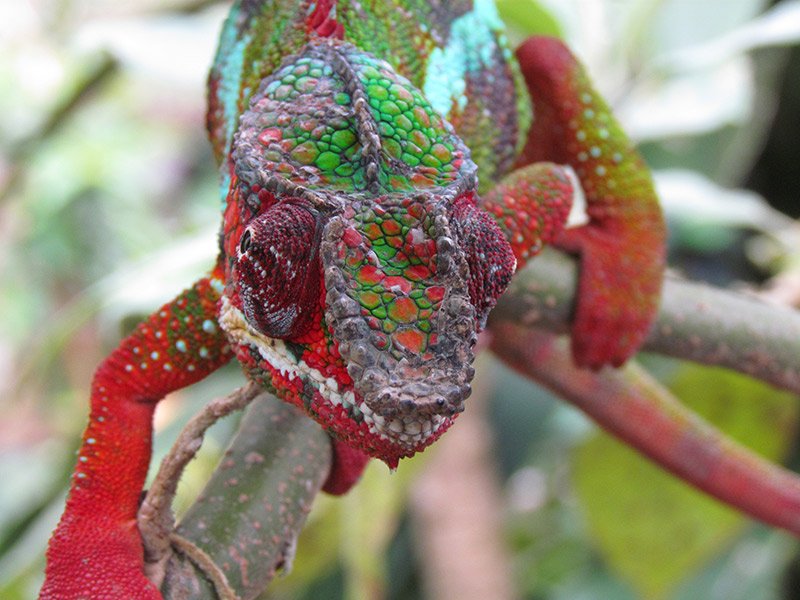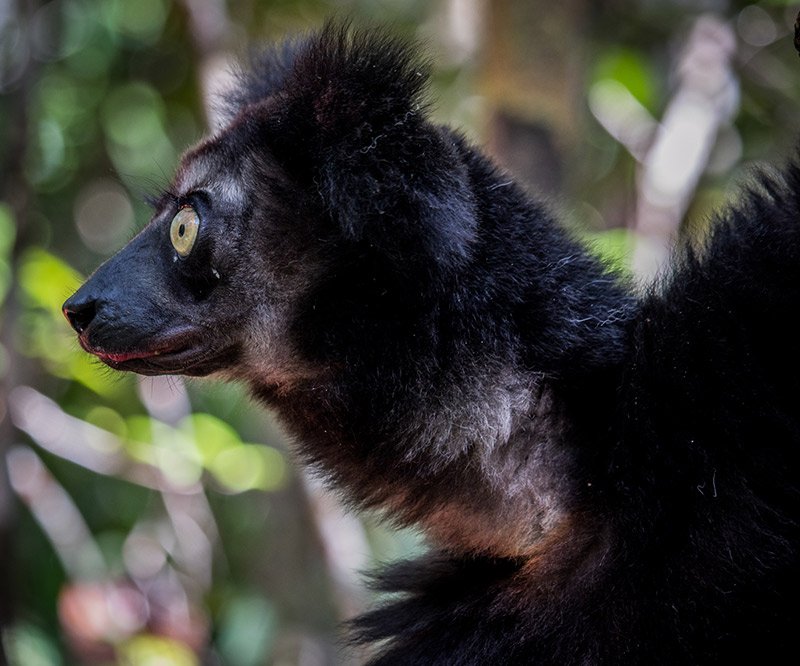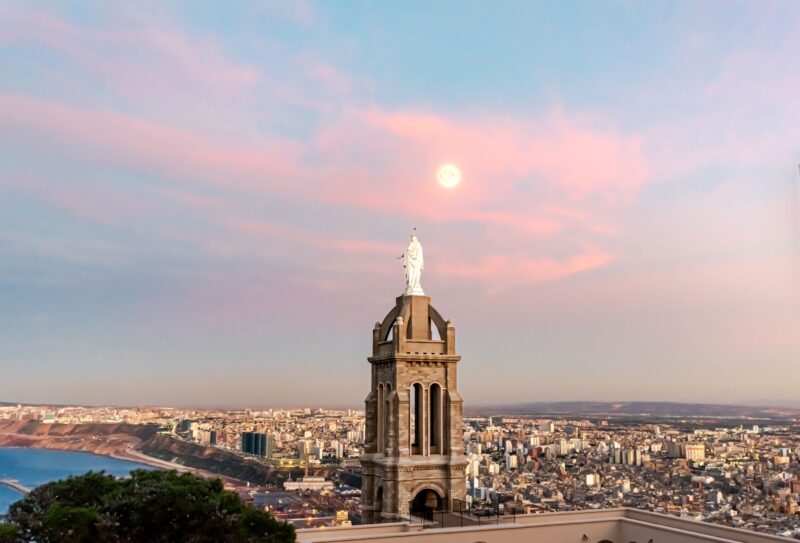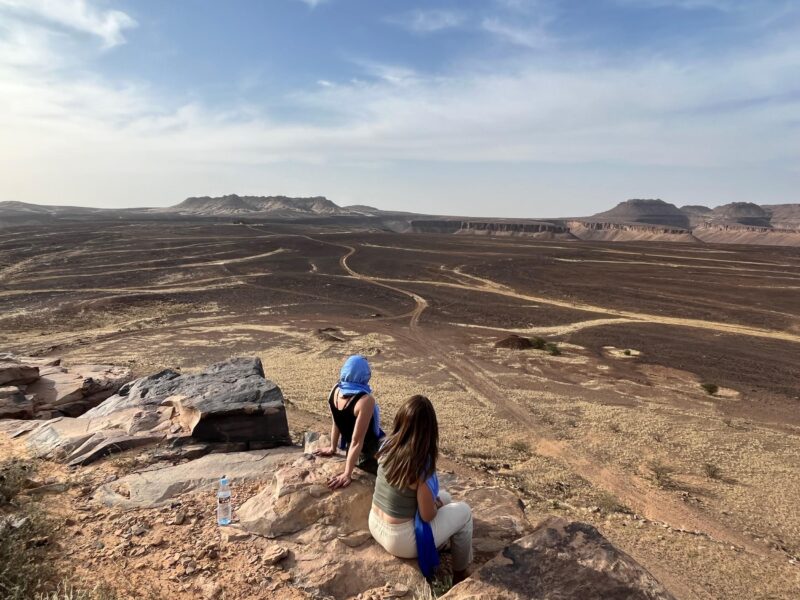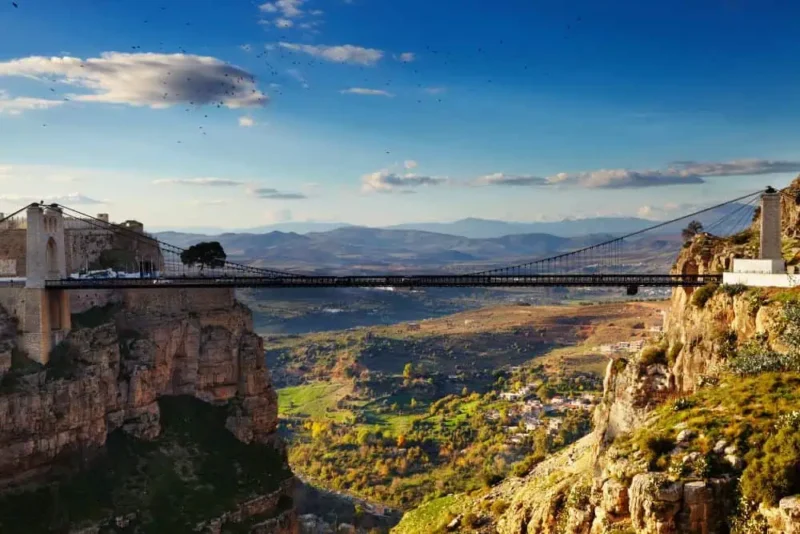| Tour Code | Start | End | Trip Status | Pricing Per person |
|---|---|---|---|---|
| MSM/140526 |
May 14, 2026
Thursday |
May 31, 2026
Sunday |
Guaranteed |
£3,645.00
Single Room Supplement: £540.00 |
| MSM/180626 |
Jun 18, 2026
Thursday |
Jul 05, 2026
Sunday |
Guaranteed |
£3,645.00
Single Room Supplement: £540.00 |
| MSM/230726 |
Jul 23, 2026
Thursday |
Aug 09, 2026
Sunday |
Guaranteed |
£3,645.00
Single Room Supplement: £540.00 |
| MSM/240926 |
Sep 24, 2026
Thursday |
Oct 11, 2026
Sunday |
Guaranteed |
£3,645.00
Single Room Supplement: £540.00 |
| MSM/151026 |
Oct 15, 2026
Thursday |
Nov 01, 2026
Sunday |
Guaranteed |
£3,645.00
Single Room Supplement: £540.00 |
| MSM/130527 |
May 13, 2027
Thursday |
May 30, 2027
Sunday |
Guaranteed |
£3,645.00
Single Room Supplement: £540.00 |
| MSM/170627 |
Jun 17, 2027
Thursday |
Jul 04, 2027
Sunday |
Guaranteed |
£3,645.00
Single Room Supplement: £540.00 |
| MSM/220727 |
Jul 22, 2027
Thursday |
Aug 08, 2027
Sunday |
Guaranteed |
£3,645.00
Single Room Supplement: £540.00 |
| MSM/230927 |
Sep 23, 2027
Thursday |
Oct 10, 2027
Sunday |
Guaranteed |
£3,645.00
Single Room Supplement: £540.00 |
| MSM/141027 |
Oct 14, 2027
Thursday |
Oct 31, 2027
Sunday |
Guaranteed |
£3,645.00
Single Room Supplement: £540.00 |
Secrets of Madagascar
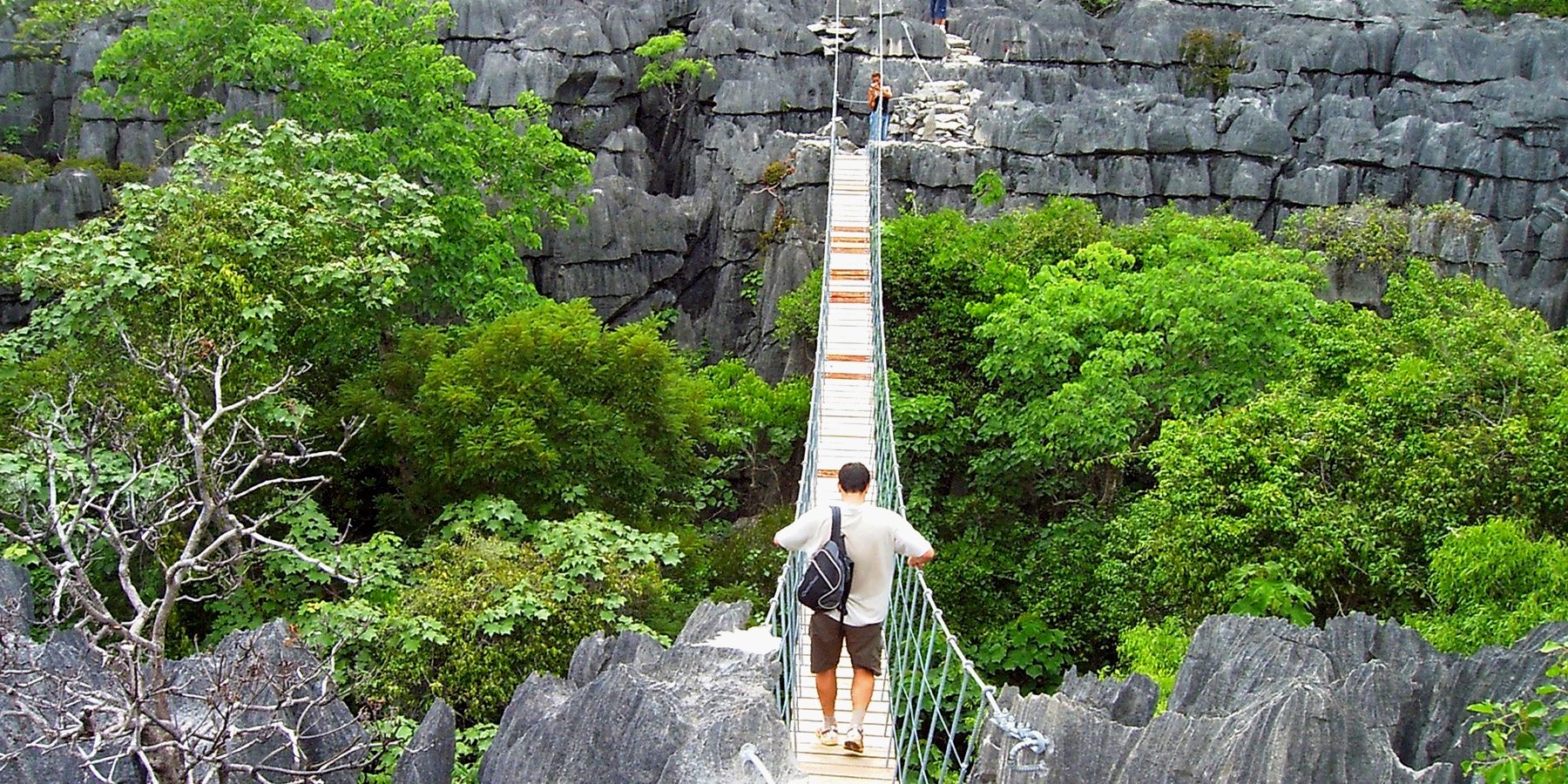
The island of Madagascar occupies a unique place, both culturally and geographically, within Africa. Separated from the mainland millions of years ago, its fauna has developed very differently from the rest of the continent’s wildlife, and it is home to countless species found nowhere else on earth. Its people are an intriguing mix of Malay and African ancestry, with complex patterns of beliefs and an unusual history. On our small group tour we take in the very best of this enigmatic and alluring land. Our journey takes us to the little visited Tsingy de Bemaraha Reserve, recognised by UNESCO as a World Heritage Site on account of its amazing rock formations, yet virtually unknown to the outside world until twenty years ago – few other operators take the trouble to reach this area, but it is without a doubt one of the highlights of Madagascar. We also visit superb national parks, including the bizarre moonscape of Isalo and the lush rainforests of Ranomafana, home to countless species of lemurs including the rare golden bamboo lemur, only discovered by scientists in 1986. We also visit Andasibe, one of the best places in Madagascar to see the curious indri, the largest species of lemur, and spend time taking walks through the forest in search of endemic wildlife. Finally, we spend time at Ifaty on the coast – a relaxing end to the trip. If you have more time to spare why not extend your stay by the beach with our Mikea Forest Beach Extension or try one of our other extensions to either the pristine forest of Anjozorobe or go tropical on the East Coast with our Pangalanes Wildlife Experience. Madagascar is unlike anywhere else on earth – join us to experience its diverse charms on a trip that will challenge what you thought you knew about Africa.
Arrival and departure transfers
Overland transport throughout with professional driver
Domestic flights as shown in the itinerary
All accommodation
Services of English-speaking guide / tour leader
Meals as listed, B – Breakfast, L – Lunch, D – Dinner
Entrance fees for sites listed as part of the itinerary
International flights (contact us for expert advice and a quote)
Any airport taxes (except included with any domestic airfares)
Travel Insurance
Visa – when required
Drinks
Items of personal nature
Tips (Discretionary)
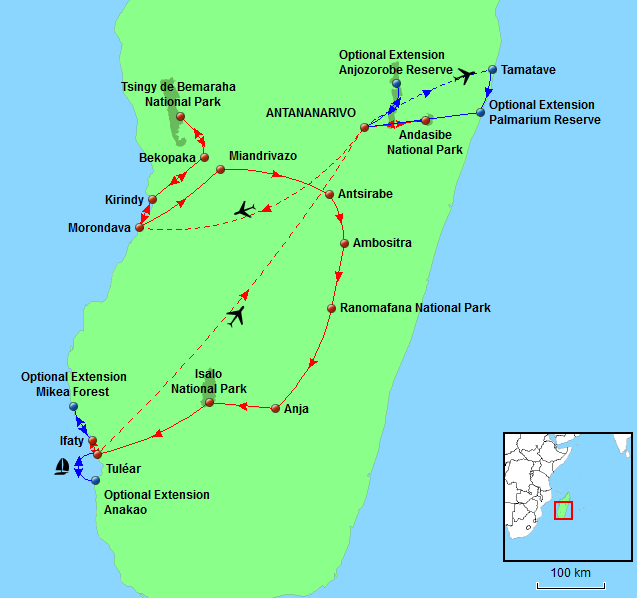
Explore Madagascar’s highlights on this immersive 18-day journey. Begin in Antananarivo, with its historic charm and local markets. Travel east to Andasibe National Park to encounter lemurs, including the indri, and visit a reforestation project. Fly west to Kirindy Reserve, home to the elusive fossa and giant baobabs. Discover the dramatic limestone pinnacles of Tsingy de Bemaraha before heading south to explore rainforests in Ranomafana and the sandstone canyons of Isalo. Enjoy scenic drives, vibrant markets, and cultural encounters in towns like Antsirabe and Ambositra. End with relaxation on Ifaty’s beaches, rich in marine life and local traditions. A final flight returns you to Antananarivo before departure.
Tsingy de Bemaraha National Park
Explore dramatic limestone pinnacles, deep canyons, and caves in this UNESCO World Heritage Site, including the adventurous Grand Tsingy circuit.
Andasibe National Park
Encounter the indri, the largest lemur species, along with chameleons and other endemic wildlife in lush montane forest.
Avenue of the Baobabs
Witness Madagascar’s iconic, centuries-old baobab trees at sunset – one of the most photographed spots on the island.
Ranomafana National Park
Trek through rich rainforest in search of rare species like the golden bamboo lemur, surrounded by waterfalls and hot springs.
Beach Time in Ifaty
Unwind on Madagascar’s southwest coast, with opportunities for snorkelling, diving, whale watching (in season), or exploring the local Vezo fishing villages.
Download the Information Pack
To download the tour full dossier, which includes a complete day-by-day itinerary breakdown and detailed tour information, fill in the details below.

Foreign Office Travel Warnings Before booking your tour, please familiarise yourself with the country specific information provided by the UK’s Foreign, Commonwealth and Development Office (FCDO) – www.gov.uk/foreign-travel-advice. This includes important information such as latest immigration requirements, and details of any travel advisories. We constantly monitor the advice posted by the FCDO. In particular we will always advise clients of any travel warnings. At present there are no warnings against travel to the parts of Madagascar that we visit on this tour. Please feel free to contact us should you have any specific concerns or would like to know in detail what measures are being taken to ensure visits remain trouble free and without incident. It should be noted that this information applies to British citizens. Other nationals are asked to check the current position of their respective government. Visa Information At the time of writing British, US and Australian nationals require a visa for a tourist visit to Madagascar if they are staying for 15 days or longer. For further details please visit the applicable website shown below. British Nationals – www.gov.uk/foreign-travel-advice US Nationals – travel.state.gov/content/travel/en/international-travel.html Australian Nationals – www.smartraveller.gov.au Other nationals should check the latest requirements with the authorities in their home country, or with the destination’s nearest embassy or consulate. Should you require any documentation to support a visa application, such as a letter of invitation, upon request this will be provided by Undiscovered Destinations after receipt of your balance payment. As it is the travellers’ responsibility to ensure that they meet all entry requirements it is essential that you check the rules and any other conditions at the time of booking and again when making your balance payment. In addition, we would strongly advise that you make a final check around two weeks before your arrival. This is important as requirements can change at short notice. Undiscovered Destinations, when possible, will provide guidance about entry rules, but in the first instance please contact the relevant authorities, including the applicable embassy or consulate for assistance. Passports It is your responsibility to ensure that you are in possession of a full passport, valid for at least six months after the date of return to your country. We strongly advise that your passport contains a minimum of two blank pages, as this may be a requirement of the local immigration authorities. In addition, certain countries will stipulate that the two blank pages are opposite each other. If you are unable to meet these requirements, you may be refused boarding by your airline or denied entry by the immigration authorities. For specific information about the requirements for your destination please check with the country’s embassy or consulate. Alternatively, UK citizens can visit www.gov.uk/foreign-travel-advice. Vaccinations & Protection As with travel to most parts of Africa, we strongly recommend that you contact your doctor’s surgery or a specialist travel clinic for up-to-date information, advice, and the necessary vaccinations. For a visit of less than one month, almost certainly you will be advised to have immunisations against the following: Diphtheria and Tetanus, Hepatitis A, Typhoid, Meningitis. The use of a DEET-containing insect repellent is highly recommended. The legal status and regulation of some medicines prescribed or purchased in your home country can be different in other countries. If you’re travelling with prescription or over-the-counter medicine, read this guidance from NaTHNaC on best practice when travelling with medicines. For further information on the legal status of a specific medicine, you’ll need to contact the embassy, high commission or consulate of the country or territory you’re travelling to. Travel Insurance It is a condition of booking with Undiscovered Destinations that you have adequate valid travel insurance. It is your responsibility to arrange appropriate travel insurance and ensure you have read and understood the full terms and conditions of your travel insurance policy to ensure that you are covered for all activities you intend to undertake whilst on the tour, including all optional activities. Your Insurance Policy must fully cover you for medical expenses (including cover for Covid-19 conditions) and emergency repatriation to your home country and be valid for the entire duration of your holiday. Local Conditions When travelling to our destinations, many of which are underdeveloped and untouristed by mainstream tourism, a good deal of patience and a sense of humour is an important attribute. This will help you to cope with problems such as ageing or poor infrastructure and when maintenance may not be as high as we would always like. The choice of appropriate accommodation in some towns and cities (particularly the smaller places) can be limited, and standards of both service and maintenance can be less than polished. Guides and other service providers in some of our destinations do not always have the decades of collective practice and experience that their counterparts in more developed countries can draw upon. Although we will always try and resolve any issues as quickly as possible, on occasions there may be some shortcomings which no matter how hard we try will be unavoidable.
